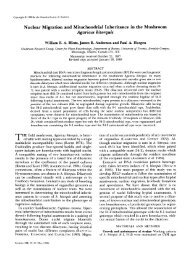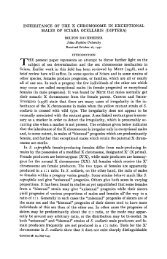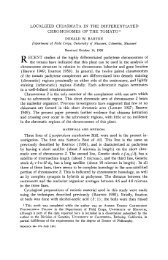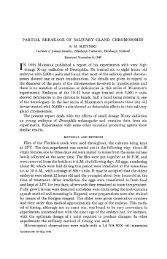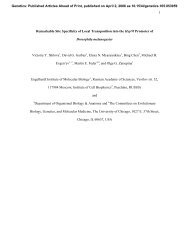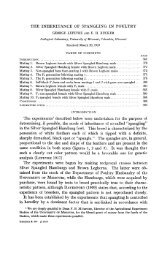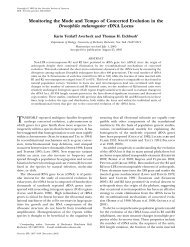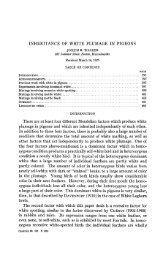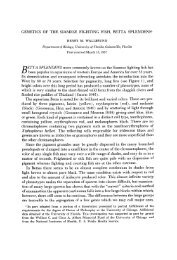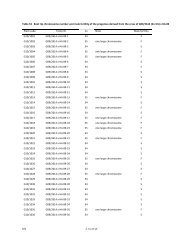abstracts of papers presented at the 1962 meetings - Genetics
abstracts of papers presented at the 1962 meetings - Genetics
abstracts of papers presented at the 1962 meetings - Genetics
You also want an ePaper? Increase the reach of your titles
YUMPU automatically turns print PDFs into web optimized ePapers that Google loves.
ABSTRACTS 953<br />
Fox, A. S., I. L. MUNYON, I. P. SINGH, and E. A. SWEENEY, Michigan St<strong>at</strong>e University, East<br />
Lansing, Michigan: Genetic determin<strong>at</strong>ion, amino acid composition, and syn<strong>the</strong>sis <strong>of</strong> <strong>the</strong> sez<br />
peptide <strong>of</strong> males in Drosophila me1anogaster.-The peptide characteristic <strong>of</strong> adult males has<br />
been purified by paper and column chrom<strong>at</strong>ography. Acid hydrolysis yields ten ninhydrinpositive<br />
products. Nine <strong>of</strong> <strong>the</strong>se have been identified: a-alanine, aspartic acid, ethanolamine,<br />
glutamic acid, glycine, leucine, methionine, serine, and valine. The tenth remains unidentified.<br />
Ethanolamine must occupy wh<strong>at</strong> would o<strong>the</strong>rwise be <strong>the</strong> C-terminal position <strong>of</strong> <strong>the</strong> peptide<br />
chain, or constitute a side branch through peptide linkage with one <strong>of</strong> <strong>the</strong> dicarboxylic amino<br />
acids or through phosph<strong>at</strong>e linkage with serine. Preliminary results suggest th<strong>at</strong> <strong>the</strong> unidentified<br />
residue is N-terminal.-The sex peptide first appears in males two hours after emergence. Phosphoethanolamine<br />
is present in male third instar larvae and pupae, but not in females. This<br />
disappears just prior to <strong>the</strong> appearance <strong>of</strong> <strong>the</strong> sex peptide, suggesting th<strong>at</strong> it represents <strong>the</strong><br />
source <strong>of</strong> <strong>the</strong> ethanolamine in <strong>the</strong> peptide, which is syn<strong>the</strong>sized during this period.-Sex peptide<br />
is present in all 1X/2A genotypes (males) and absent in 2X/2A genotypes (females) regardless<br />
<strong>of</strong> <strong>the</strong> presence <strong>of</strong> an intact Y, or YS or YL. Females (2X/2A) transformed into intersexual<br />
males by <strong>the</strong> recessive third chromosome mutant transformer exhibit <strong>the</strong> peptide in <strong>the</strong> same<br />
concentr<strong>at</strong>ion rel<strong>at</strong>ive to <strong>the</strong> total free amino acid and peptide pool as do normal males. Therefore,<br />
<strong>the</strong> presence or absence <strong>of</strong> <strong>the</strong> sex peptide does not depend on <strong>the</strong> presence or absence <strong>of</strong><br />
one or more genes, but on <strong>the</strong> balance <strong>of</strong> sex determiners and modifiers. This conclusion will be<br />
discussed in terms <strong>of</strong> regul<strong>at</strong>ory mechanisms in protein syn<strong>the</strong>sis. (Supported by grants from<br />
<strong>the</strong> N<strong>at</strong>ional Institutes <strong>of</strong> Health (C-2440) and <strong>the</strong> Rackham Research Endowment.)<br />
FRYE, SARA H., 701 Atw<strong>at</strong>er, Bloomington, Ind.: Concerning <strong>the</strong> X-ray dose-frequency rel<strong>at</strong>ion<br />
for minute chromosome changes in <strong>the</strong> yellow region in Drosophila me1anogaster.-Totals <strong>of</strong><br />
yellow mutants, X-ray-induced in y+ scute-8 chromosomes <strong>of</strong> m<strong>at</strong>ure and nearly m<strong>at</strong>ure sperm<br />
ejacul<strong>at</strong>ed 0-2 and %4 days after irradi<strong>at</strong>ion), were found to exhibit approxim<strong>at</strong>ely a linear<br />
dose-frequency rel<strong>at</strong>ion. The presence or absence (inactiv<strong>at</strong>ion) <strong>of</strong> markers closely linked to<br />
yellow was determined by genetic analyses <strong>of</strong> 98% <strong>of</strong> <strong>the</strong> 558 yellows th<strong>at</strong> were able to breed<br />
and were transmitted. Intergenic or “breakage” yellows accounted for 96-98% <strong>of</strong> <strong>the</strong> transmissible<br />
yellows and <strong>the</strong>se were roughly classified into “only minute” and “gross” chromosome<br />
changes.-The induced frequencies <strong>of</strong> “only minutes” varied significantly below linearity with<br />
dose, whereas those <strong>of</strong> “gross changes” varied significantly above linearity. Hence, <strong>the</strong> linear<br />
dose-frequency rel<strong>at</strong>ion <strong>of</strong> total yellow mutants is complex and consist <strong>of</strong> <strong>at</strong> least three presumptive<br />
components: sublinear, linear, and supralinear. Dose frequencies <strong>of</strong> <strong>the</strong> “only minutes” did<br />
not disagree significantly with th<strong>at</strong> expected were <strong>the</strong>y proportional to <strong>the</strong> 0.8 dose power. However,<br />
dose frequencies <strong>of</strong> total minutes accorded s<strong>at</strong>isfactorily with <strong>the</strong> <strong>the</strong>oretical expect<strong>at</strong>ion <strong>of</strong><br />
linearity if <strong>the</strong> total minutes included those gross yellows “capped” by a transloc<strong>at</strong>ed autosomal<br />
end piece and o<strong>the</strong>r simultaneous gross and minute yellow changes lost by aneucentricity.<br />
Availability <strong>of</strong> a more accur<strong>at</strong>e criterion <strong>of</strong> minute versus gross than <strong>the</strong> determin<strong>at</strong>ion <strong>of</strong> which<br />
side <strong>of</strong> bb’ <strong>the</strong> right-hand break lay on would have yielded more homogeneous classes and<br />
sharper dose-frequency rel<strong>at</strong>ions.-The dose-frequency criterion is more likely to be meaningful<br />
where heterogeneities, such as germ cell tre<strong>at</strong>ed, structure <strong>of</strong> <strong>the</strong> mutants, and o<strong>the</strong>rs (to be<br />
discussed) are minimal. (A.E.C. grants AT (11-1)-195 to H. J. MULLER and associ<strong>at</strong>es and<br />
AT (11-1)-133 to I. H. HERSKOWITZ and associ<strong>at</strong>es.)<br />
FUERST, R., and LI-CHUN LI, Texas Woman’s University, Denton, Texas.: Biosyn<strong>the</strong>ses <strong>of</strong><br />
panto<strong>the</strong>n<strong>at</strong>e homoIogs.-WAc” and GUIRARD (1948) demonstr<strong>at</strong>ed th<strong>at</strong> mycelium <strong>of</strong> wildtype<br />
Neurospora crassa Em5256A was able to syn<strong>the</strong>size panto<strong>the</strong>nic acid from beta alanine<br />
and pantoyl lactone.-Extending this syn<strong>the</strong>sis to possible homologs <strong>of</strong> panto<strong>the</strong>nic acid, it was<br />
found th<strong>at</strong> acetone-dried mycelium <strong>of</strong> wild-type and some panto<strong>the</strong>nicless mutants was able to<br />
syn<strong>the</strong>size gamma panto<strong>the</strong>n<strong>at</strong>e from pantoyl lactone and gamma-amino butyric acid. Under<br />
some conditions delta panto<strong>the</strong>n<strong>at</strong>e was also syn<strong>the</strong>sized from delta-amino valeric acid and





